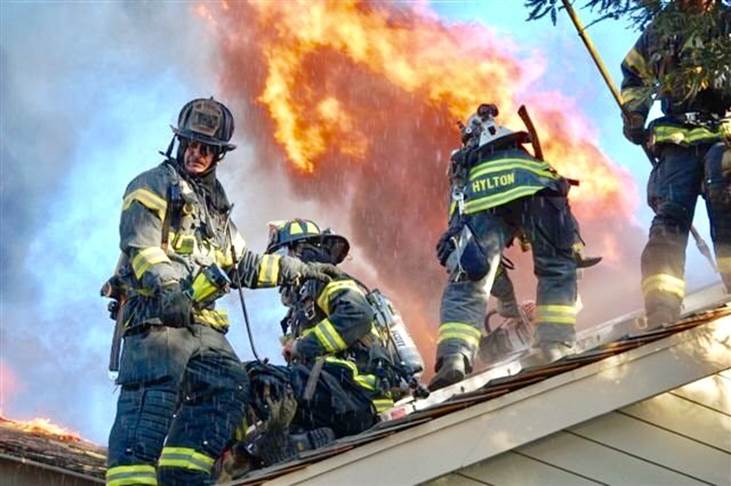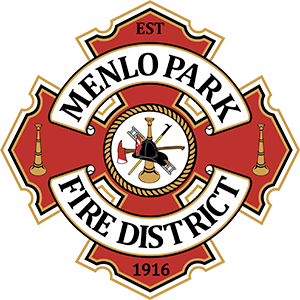Published on February 21, 2019
The Menlo Park Fire Protection District is one of the first Fire Agencies in the State of California to comply with new regulations that requires it to report to its elected body and the community on the completion and compliance of State Mandated Inspections in the wake of the deadly 2016 Ghost Ship Fire in Oakland

Menlo Park Firefighters – Credit Menlo Fire
Menlo Park Fire Protection District – California – February 18, 2019
After the tragic 2016 “Ghost Ship Fire” in Oakland that killed 36 people, Senator Jerry Hill introduced SB 1205 The Fire protection services - Compliance Reporting. The bill was passed and Section 13146.4 was added to the States Health and Safety Code last year.
On Tuesday, February 19, 2019, at 7 pm, in the Training Room at Fire Station 1 located at 300 Middlefield Road in Menlo Park, the Menlo Park Fire Districts Board will be one of the first Fire Agencies in the State to comply with this new important reporting requirement.
Fire Board President Virginia Chang Kiraly said “we are looking forward to hearing from the Fire Chief and Fire Marshal on this extremely important topic and making sure we are in full compliance”.
That wasn’t always the case for the Fire District, which provides essential emergency services and critical fire code inspections to its areas in the Town of Atherton, Cities of East Palo Alto, Menlo Park and portions of Unincorporated San Mateo County.
Over a decade ago, the Fire District had decided to not only have its Fire Companies conduct State Mandated Inspections, but decentralized its record keeping processes which meant that each Fire Station worked in its own silo, with little to no communications and actual accountability.
Fire Chief Schapelhouman said “I discovered this issue in 2009 after becoming the Fire Chief in 2007. We were working through some major life safety and code compliance issues at an apartment complex in East Palo Alto owned and managed through the now defunct Page Mill Properties Team when they threatened to bring a law suit against the Fire District. When I asked to see the inspection file, I was told we would need to get it from the Fire Station. That was both shocking and obviously unacceptable to me”.
For the next three years, the Fire District developed a model easy to use, field friendly, inspection accountability process and record keeping program. Management needed to be in the center of this effort because they were ultimately accountable and responsible, but they needed to be equally supportive of the Fire Prevention Bureau, its Inspection staff and most importantly the Engine Companies who were doing most of this important work in the field.
With the help of the District’s Information Technology Team, First Responders, Prevention Staff and Management Team, a tracking dash board was developed using I-Pads for data entry. Mandated inspections were divided up amongst all Fire Stations and Shifts, and progress was monitored monthly at the line level and quarterly by senior leadership.
Once that was in place and working well, the Fire Marshal conducted a survey of the entire Fire District in 2014 to verify all the occupancies operating within its jurisdiction.
Utilizing a spreadsheet from the San Mateo County Tax Assessors office, a contractor surveyed every building within the Fire District. It took one year to develop the most comprehensive and accurate database at that time that included hundreds of new businesses which were updated and added to this vital information database.
Under direction of the Fire Marshal, inspections are divided between engine companies and fire inspectors to perform annually. The inspections performed annually are state mandated inspections, and non-mandated businesses are slated to be performed as often as possible, or between 1-3 years. This is due to a commitment to providing community education, safety and excellent customer service within the Fire District.
The CA State Fire Marshal mandates inspections to be performed annually in all public and private schools (Group E Occupancy), large family daycares, hotels, motels, lodging houses, apartment houses and dwellings (Group R-1, R-2, R2.1,R-4 Occupancy) and High rises. Jails and care facilities (Group I Occupancy) shall be performed every two years. A total of 827 State mandated inspections were identified for 2018. 823 sites were visited at least once for an inspection with four identified as not having an inspection performed in calendar year 2018. This was a 99.5% acceptance rate. Upon identification, inspections were immediately performed in January 2019 for the four missed inspections. Engine companies performed a total of 1,306 business inspections and Fire Prevention staff performed an additional 347 business inspections, for a total of 1,653.
“When Senator Hill proposed the legislation, we reached out to him and provided details on what we were doing and how we had gotten to where we currently are as to what we believe is a model program. Unfortunately, all too often, many fire agencies tasked with both emergency response and code compliance primarily focus on first response, especially when budgets get tight or their full attention is diverted from the importance of mitigation, inspection and code compliance”, Chief Schapelhouman said.
The State of California allows through the Health and Safety Code “Any fee charged pursuant to the enforcement authority of this section shall not exceed the estimated reasonable cost of providing the service for which the fee is charged, pursuant to Section 66014 of the Government Code.” The Menlo Park Fire Protection District has not charged fees for annual inspections as it was felt that it is a service that is provided for by property taxes.
BACKGROUND:
The California State Fire Marshal, through the CA Health and Safety Code, mandates that certain occupancies are to be inspected annually. Since the Ghost Ship Fire grand jury investigations searched for other high risk and illegal occupancies that could put the public at risk. The outcome of the investigations determined that the state required annual inspections on various occupancies however, they were not mandated to be reported to any governing body. Senate Bill 1205, authored by Senator Jerry Hill, was successful in requiring the reporting of annual inspections to its administering authority on an annual basis.
SB 1205, Hill. Fire protection services: inspections: compliance reporting.
Existing law requires the chief of any city or county fire department or district providing fire protection services and his or her authorized representatives to inspect every building used as a public or private school within his or her jurisdiction, for the purpose of enforcing specified building standards, not less than once each year. Existing law requires every city or county fire department or district providing fire protection services that is required to enforce specified building standards to annually inspect certain structures, including hotels, motels, lodging houses, and apartment houses, for compliance with building standards.
This bill requires every city or county fire department, city and county fire department, or district to perform the above-described inspections to report annually to its administering authority on the department’s or district’s compliance with the above-described inspection requirements. The bill also requires the administering authority to acknowledge receipt of the report in a resolution or a similar formal document.
The people of the State of California do enact as follows:
SECTION 1.
Section 13146.4 is added to the Health and Safety Code, to read:
13146.4.
(a) Every city or county fire department, city and county fire department, or district required to perform an annual inspection pursuant to Sections 13146.2 and 13146.3 shall report annually to its administering authority on its compliance with Sections 13146.2 and 13146.3.
(b) The report made pursuant to subdivision (a) shall occur when the administering authority discusses its annual budget, or at another time determined by the administering authority.
(c) The administering authority shall acknowledge receipt of the report made pursuant to subdivision (a) in a resolution or a similar formal document.
(d) For purposes of this section, “administering authority” means a city council, county board of supervisors, or district board, as the case may be.
More: Home News
